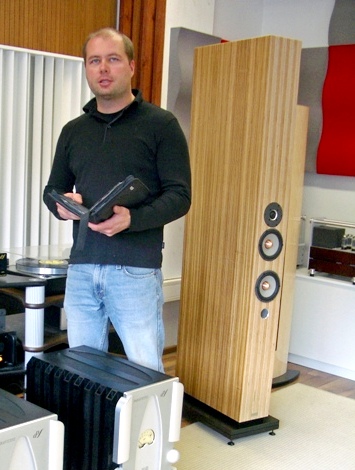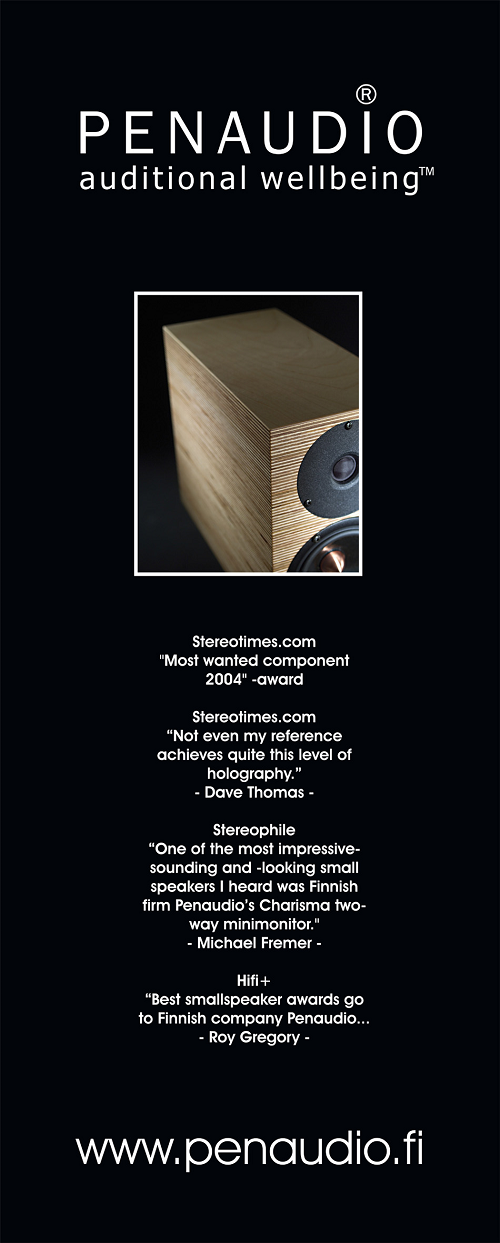
Penaudio is known for promoting auditory wellbeing, the good feeling that one can retrieve from music and the reproduction system, if properly tuned. But as you know, there are other pleasures in life. Does it matter where the pleasure comes from, or should we distinguish between different kinds of pleasure? Perhaps value one type of pleasure over the other? Or is pleasure just pleasure?
“Hmmm… music and cooking … driving a car, how are they related? I think what combines them is a natural strive for a higher experience. Music, for example. I play piano, bass and guitar … by changing better parts, strings for example, makes the sound better. The same goes with food. Fresh subsidies, cooking them with gas using high quality pots and knives and so on. Likewise with tuning cars, improving them with better quality components etc.”
So it’s all about tuning? Tuning, tuning, tuning.
“You might say I’m obsessed with tuning. Better components, better raw materials etc. mean a lot me. But I stress that it’s not just a matter of using expensive parts and materials, rather, one has to know what one wants. In music it is the kind of sound one wants from an instrument that one has to know, in cooking knowing the taste one is looking for is essential, on the track one has to know one’s driving, to what direction one wants his or her abilities to go. Thus, seeking pleasure also comprises of using and developing one’s knowledge. And yet, it is all about the taste, that is, subjective. That’s what makes pleasures so interesting.”
It’s generally accepted that certain meals require or benefit from certain type of wine to go with. But do meals require certain type of music to go with too?
“Yes I think so. I’ve been studying red wines, and they’re frequently required for certain type of food, Italian wines usually go well with pasta and lighter foods whereas for example Argentinian wines are good for grilled, more spicy food. When I’m planning a good dinner, right music is also part of it. It boosts all your senses and perfects the dinner. And vice versa, if you are just hanging around with friends in the evening eating some salad and pie, you may need more powerful music to create a tasty mixture of all. And special nights with your love one may require some smaller scale sensitive music … maybe a string quartet, or maybe some Italian food and Italian wine with a solo violin … live!”

When you set out to listen to your new speakers models, will it only be music that you yourself find pleasurable? Or do you, for the sake of being a bit more impartial, also use music and records that you don’t personally fancy that much?
“In our factory, when I listen to new prototypes I usually listen to all sorts of music: Finnish pop/rock, classical stuff: solo piano, cello, violin, some blues and jazz. I always try to include some music samples from every genre that I also like myself. Otherwise it would only be irritating. If the listener has to spend hours and hours by listening to speakers, there must be some music that the listener likes and could go back later. Actually my selection of test music hardly has pieces I don`t like. I also listen to some crappy recordings but with good music, just to check certain aspects of the sound.”
Penaudio is known for its policy of seeking sonic improvement by making use of better and more expensive drivers, OEM Seas Excel drivers especially. What is the share of the drivers in the final sound quality?
“Drivers make the speakers as does the crossover. The designer would not achieve anything significant by using drivers that dont’ behave like he expects, or show certain undesirable tunes in the test bench. I can`t say exactly how much of the final sound is due to the drivers but if I say 50% I wouldn`t be completely off the track. Personally, if I cannot get the sound that I require from the drivers when they’re in the test bench, I let them go. But with good sounding drivers one can do magic things with appropriate crossover parts, stuffing, cabling and cabinet. So, a vast part of my research work is to find the best possible drivers given the price point.”
Penaudio has long been quite popular in Japan. Apart from the sound, is it the cabinet design and the the veneer ply finish that attracts Japanese customers or some other feature?
“In Japan or in Asia in general, where we’re selling most of our products, they really seem to have an eye for plywood stripes, and the fact that they do is natural in their culture, having to do with the way in which they use bambu and so on. They are also familiar with Alvar Aalto whose architecture, design and style was our guideline while designing the Penaudio plywood finish. It was actually first time that a loudspeaker manufacturer used plywood stripes in that particular way. We introduced it in 2002 at the Frankfurt Highend show. Simple lines, small, narrow cabinets and the manufacturer being an exotic Finn, fascinated the public there. That is something that one cannot copy. For the same reason I like Italian design, for example, in my cars: the rims, pedals, steering wheel… also their clothes fascinates my eye. You may copy the pizza but you cannot copy the style.”
What do you mean by the saying “Each individual Penaudio product must earn its own design value”?
“Each speaker has to be different yet meet the same Penaudio sound criteria for the design, performance and lifestyle.”
Is there a limit as to how much a small standmount 2-way speaker could cost or should not cost?
“In my opinion a quality 2-way standmount speaker could cost quite a lot, and then its performance would be ”perfect”, and especially in the room where installing a floorstander would be an impossibility acoustically. Beyond that limit, I would require some custom things… say some rare finish etc.”
Penaudio’s philosophy text outlines that “listening to music should be as effortless and free-flowing as the notes themselves”, and that “natural sound combined with ease of access will make one happier and more relaxed” by promoting one’s “auditory wellbeing”. Could you elaborate a bit on the idea of the sound being effortless and easygoing yet natural?
“By ”effortless” we mean that Penaudio speakers are easy to place. Sound is excellent and “right” in any environment excluding of course so small rooms that one should listen to music only with headphones. Many speakers require precise placement and positioning. With our new crossover design and internal wiring Penaudio speakers “mate” with any amp and simply play music. They sound natural and allow the listener focus on the music and not the equipment.”
 For internal cabling you’ve used eg. Jorma-cables from Sweden, Analysis Plus Blue Oval, Goertz MI1 cables etc. What sort of change in sound do you expect from the change of cables?
For internal cabling you’ve used eg. Jorma-cables from Sweden, Analysis Plus Blue Oval, Goertz MI1 cables etc. What sort of change in sound do you expect from the change of cables?
“As I mentioned, we are putting a lot of R&D to searching new better sounding components. Internal cabling is one of them. For long we’ve been using Jorma Design cables as speaker cables in many equipment combinations. They sound pure, natural and balanced, so it was natural that we started to make prototypes using them for internal wiring. We noticed that they sounded better in every combination. They didn’t show any problems with integration that other cables sometimes did.”
You started with 2- or 3-way designs, but then surprised all by making Sara to be your first 2,5 way speaker. How much more difficult it was to design a well-functioning crossover for Sara?
“Designing a well-working cross-over for Sara wasn`t easy. I tried 3-way, pure 2-way, D´Appolito and ended up with using a 2,5-way configuration. With that I got the sound I preferred more easily, and the way I like to tune the filters. Also, I could control a little bit the directiviness of the speaker in the area where that’s most needed, 100-500Hz and also the baffle step.”
Audiophiles always debate about having the best amplification for a certain speaker. I know you’ve used Sonneteer’s amplifiers among others. What sort of amplification would you recommend for your speakers?
“Finding best amplification is like finding a great wine for certain food. Expensive ones are usually good choices, but one can find a good one also from the less expensive ones. Sonneteer has decent Class AB and Class D solid state amps, and they are our R&D tools. We have noticed that if speakers play good with the Sonneteer amps, they will also perform well with more expensive and less expensive ones. Some may think that there are certain extra reasons why we use Sonneteer, but it is I who decide which components we are using inside the speaker and to drive the speakers. They must sound excellent and fulfill my preferences. I make tests with the electronics we’re using with our speakers, and if there is something better than what we have now, I will use them. That’s so simple. By better I mean a better sound. We’re using Almarro amps as our tube reference, and Denon and Yamaha to test our speakers with home theatre amps, and so on.”
Thanks, Sami.








